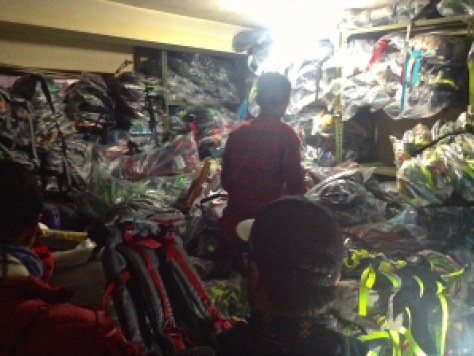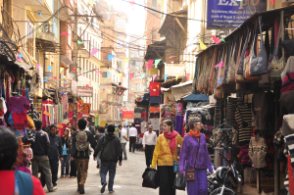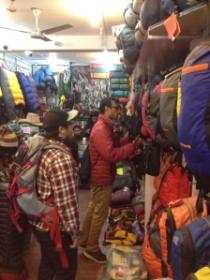The Rapidly Changing Culture of a Modern Myanmar
Bagan is home to Myanmar’s precious “Valley of a Thousand Temples”. It is a place quite unlike anything you’ve ever seen, a landscape that is both barren, and vibrant, and host to an ancient culture that is in the midst of modernization.

There are many questions left to be answered regarding this modernization, especially with regards to the new youth of Myanmar, many of whom are now working in the tourism industry, a business that didn’t exist when their parents were their age. Many Burmese people, both young and old, have acknowledged that as Myanmar opens itself up to the world, it is inevitable that change will happen. However, both have expressed sentiments that aim to preserve as much of their traditional culture as they can. As I walked around the plains of Bagan, meeting with locals and travelers alike, I asked myself, how will Myanmar look in 10 years? It was then, that I met a young Burmese girl, who introduced herself as Ma (younger sister in Burmese). She approached me, with a stack of foreign money in her hand, and asked me where I was from. I told her the United States, and she promptly spoke to me in English. Perfect English, not a word wrong, her accent was impeccable. She reminded me of a highly intelligent young girl in junior high. So what was she doing with a stack of money from all over the world?
“I can speak all of these languages” she told me.

“Every single one?” I looked at the stack, there were bills from all over the world. France, Brazil, England, Chile, China, everyone was accounted for.
I tried Spanish with her, she nailed it. French, again, perfect. Her Portuguese was good enough to get her a job in Rio. I couldn’t believe it. We walked for some time, and she told me how she learned so much.

“Tourists are my teachers” she said with a smile. Ma has been a tour guide for 5 years, literally starting as soon as the borders opened. In that time, she has worked all around Bagan, hiking from one temple to the next, with a bag full of postcards, and foreign currency. From sunrise to sunset, this has been her life. As the tourists come in larger and larger numbers, Ma has seen more and more business. So, how is this influx of global culture affecting young people like Ma?
In a recent study published by Routledge, a publishing company that specializes in providing academic books and journals regarding humanities and social sciences, researchers went to Bagan, and conducted interviews with locals, who described the three biggest changes that they had seen since the opening of the borders. People of all ages agreed on three major areas; the consumption of alcohol, the way thanaka (traditional make-up of the Burmese people) is worn and the perceived importance of marriage (Rich and Franck 334-44). Although, tourism in not alone to blame for these changes. Free access to the Internet has also helped foster a developing mindset in the minds of many young Burmese people, especially with regards to drinking alcohol, and relationships. According to the study, it is in conjunction with modern media formats that Burmese people have been exposed to and have assimilated new cultural identities.

There are undoubtedly benefits to tourism, and most locals do agree that those benefits are very important to providing new opportunities for the next generation. Many young men and women are now able to afford luxuries that their parents could not have thought possible at their age, and many more are able to attend schools now. Whatever future these changes hold in store for Myanmar, it is important to learn from the successes and failures of nearby destinations like Thailand and Cambodia. Will Bagan’s Valley of a Thousand Temples someday have backpacker ghettos lined up across it’s plains? Will the environment suffer the way it has in some parts of Thailand? These questions are left to the people of Myanmar to manage, and to hopefully, resolve. Either way, it is a fascinating time to be young in Bagan ;a time when the new generation is setting out to define itself, and decide what direction it wants this new Myanmar to go.
Source Citation:
Rich, Anna-Katharina, and Anja K. Franck. “Tourism Development in Bagan, Myanmar: Perceptions of Its Influences upon Young Peoples’ Cultural Identity.” Tourism Planning & Development 13.3 (2015): 333-50. Print.
For anyone interested in reading more about Myanmar, here are some interesting books to check out:
The River of Lost Footsteps, Thant Myint-U. New York: Farrar, Straus and Giroux, 2006.
Freedom from Fear, Kyi, Aung San Suu. London: Viking, 2009.
















































 As the owner of Eva Lanka hotel on the Tangalle coast, he relies on the winter months to make up for the empty rooms of summer. Each year guests return and new ones flood in for Christmas and New Years celebrations. Yet, each year Paolo’s personal beach for surfing has remained untouched by the influx of tourists.
As the owner of Eva Lanka hotel on the Tangalle coast, he relies on the winter months to make up for the empty rooms of summer. Each year guests return and new ones flood in for Christmas and New Years celebrations. Yet, each year Paolo’s personal beach for surfing has remained untouched by the influx of tourists.
 Observing the Australian investing in the beach inspired the regular fisherman to do the same. Overnight the fisherman summed his savings and began building a ‘bed & beach bar’ next door. Though he started after the Australian, they both finished in late October – just in time for the high season. Each location had ‘tourist’ prices and an impressive amount of beach furniture.
Observing the Australian investing in the beach inspired the regular fisherman to do the same. Overnight the fisherman summed his savings and began building a ‘bed & beach bar’ next door. Though he started after the Australian, they both finished in late October – just in time for the high season. Each location had ‘tourist’ prices and an impressive amount of beach furniture.

 Rourke Healey is a senior Diplomacy and World Affairs major at Occidental College. He recently returned from conducting research on middle class consumerism in Dar es Salaam, Tanzania. He has also recently completed work with a microfinance group in Kathmandu, Nepal and visited Tangalle, Sri Lanka to cover presidential election.
Rourke Healey is a senior Diplomacy and World Affairs major at Occidental College. He recently returned from conducting research on middle class consumerism in Dar es Salaam, Tanzania. He has also recently completed work with a microfinance group in Kathmandu, Nepal and visited Tangalle, Sri Lanka to cover presidential election.



 Rourke Healey is a senior Diplomacy and World Affairs major at Occidental College. He recently returned from conducting research on middle class consumerism in Dar es Salaam, Tanzania. He has also recently completed work with a microfinance group in Kathmandu, Nepal and visited Tangalle, Sri Lanka to cover presidential election.
Rourke Healey is a senior Diplomacy and World Affairs major at Occidental College. He recently returned from conducting research on middle class consumerism in Dar es Salaam, Tanzania. He has also recently completed work with a microfinance group in Kathmandu, Nepal and visited Tangalle, Sri Lanka to cover presidential election.





